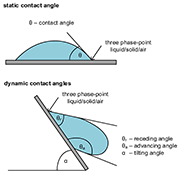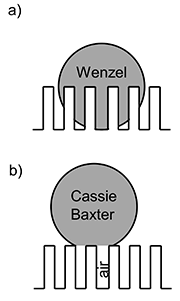E-Archive
Science Update
in Vol. 18 - March Issue - Year 2017
Effect Of Dynamic Contact Angles On The Suitability Of Pre-treatments For Coating Applications

Figure 1: Static and dynamic contact angle measurement

Figure 2: Wetting of nonideal surfaces; a) Wenzel’s model; b) Cassie-Baxter’s model

Figure 3: Exemplary results of shift Δs and contact angle θ for an untreated AlMg3-workpiece

Figure 4: Exemplary results of shift Δs and contact angle θ for a lapped AlMg3-workpiece

Figure 5: Exemplary results of shift Δs and contact angle θ for a double-face grinded AlMg3-workpiece
Introduction
Surface coatings are required to protect surfaces of workpieces against external environmental influences. Surface plating can raise the lifetime and durability of components and improve several functional characteristics such as corrosion resistance and wear behaviour of the workpiece. Besides the change of functional characteristics, surface coatings are used to modify the appearance and haptic characteristics of coated workpieces.
Applying a coating has to meet certain requirements on the surface of the workpieces. Despite the roughness, cleanliness and surface activation, the adhesive strength between the surface of the workpiece and the coating can depend on the surface structure of the workpiece [1]. The mechanism of adhesion through mechanical connection is based on the assumption that the surface bonding depends on the size of the contact area between the coating and the surface of the workpiece [2, 3]. On the other hand, specific structures can enable a mechanical anchoring of the coating on the workpiece [4].
Dynamic contact angle
One method of examining the suitability of a surface for applying a coating is the investigation of the dynamic contact angles of a liquid on the examined surface, especially the advancing contact angle θa, the receding contact angle θr and the roll-off angle αr. In comparison to the standard contact angle measurement on flat surfaces, Figure 1, the dynamic contact angles provide information about the wettability by the advancing contact angle θa and repellency by the receding contact angle θr of surfaces. Furthermore, the roll-off angle αr is the measure for the angle of inclination of a surface at which an applied liquid loses its bonding with the surface and drops off. The roll-off angle αr represents the angle at which the left and right three-phase-points, the point where the liquid, the solid surface and the ambient air meet, shift at least one millimetre. The used measuring instrument in this study was the Drop Shape Analyzer DSA100 of the company KRÜSS GmbH, Hamburg, Germany, which allows the measurement of all mentioned characteristic values.
The wettability of surfaces can be described by using different models. YOUNG described the wetting of perfectly smooth and chemically homogeneous surfaces with liquids [5]. YOUNG’s model is used to determine the surface tension of solid workpieces, which cannot be determined directly. His developed equation associates the surface tension of the liquid and the solid, the interfacial tension between liquid and solid and the occurred contact angle θ. Measuring the static contact angle θ can therefore provide information about the characteristics of the surface of the studied samples, especially its free surface energy or surface tension. In comparison, real surfaces do have inhomogeneities and specific surface textures. When a liquid is applied to a nonideal solid surface, the wetting can be homogeneous, heterogeneous or a mixed form of both. In a homogeneous wetting regime, the liquid fills in the cavities and grooves of the surface resulting in a complete wetting of the surface and an increased surface area, which interacts with the liquid compared to the ideal surface. A model for the homogeneous wetting regime is the Wenzel model, Figure 2a. In comparison, the Cassie-Baxter model describes the heterogeneous wetting of surfaces with liquids. In these cases, the liquid is not able to suppress the air between the surface grooves and peaks. Therefore, the effective surface, which is wetted, is smaller in comparison to the homogeneous wetting. This characteristic is for example used to achieve easy-to-clean surfaces, also known as the lotus effect [6, 7]. Liquid that drops on such surfaces cannot penetrate the surface structure resulting in a low wetted surface and only few interaction points between the liquid and the surface. The liquid drops can easily roll off the surface at small inclination angles. Therefore, the roll-off angle αr for these surfaces, like all surfaces that allow heterogeneous wetting, is much smaller than those that are wetted homogenously. A homogenous wetting is furthermore the basic prerequisite for an adhesive coating. The complete wetting increases the bonding surface between coating and base material allowing a mechanical anchoring of the coating on the surface. In comparison, air inclusions due to heterogeneous wetting are the main reason for imperfections of coatings, like coating inhomogeneity and pitting have to be prevented. Thus, the measurement of the contact angle αr on pre-treated surfaces of workpieces provides evidence about the suitability of pre-treatment processes prior to coating. Pre-treatment processes try to increase the roll-off angle αr for a better homogeneous wetting by the Wenzel model.
Materials and methods
The chosen material for this research is the wrought aluminium alloy AlMg3. The aluminium alloy offers a great weight-saving potential and, due to its recyclability, an increased sustainability compared to steel parts. The workpieces have been pre-treated to change the surface roughness and to create structures in the surface. Two different surface finishing methods have been used in this research. One pre-treatment process was single-face lapping with friction coupling using a Wentzky 4R40Gr, co. Graessner KG, Stuttgart/Germany; the other one was double-face grinding with planetary kinematics using a Stähli DLM 505 HS, co. Stähli Läpp Technik AG, Pieterlen/Swiss. Both processes increased the roughness of the workpieces in a comparable way. After the pre-treatment process, the workpieces have been cleaned using an ultrasonic bath and acetone, allowing a comparison of the processes without any interference of residues or contaminations on the surface of the workpieces.
Results
The following section presents the influence of the pre-treatment methods on the surfaces of the tested aluminium alloy AlMg3.
Figure 3 illustrates the dynamic contact angle measurement for an untreated, cleaned workpiece. The static contact angle θ of water on the untreated surface (contact angle θ at a tilting angle αr = 0°) is θ = 47,1°. The roll-off angle αr is αr = 26.8°.
The workpieces have been lapped and cleaned afterwards. Lapping did not affect the static contact angle θ of water on the surface, Figure 4, with a contact angle θ = 47.5°. This results in an identical, calculated surface tension. However, the dynamic contact angle measurement shows significant differences in the advancing angle θa and the roll-off angle αr is αr = 40.8°. The measurement implies that lapping favours the wetting to the homogenous Wenzel model. Therefore, this pre-treatment is suitable for coating applications.
In comparison to lapping, the double-face grinding reduces the roll-off angle αr to αr = 19.9°. In addition, the contact angle θ was increased to θ = 90.9°. With double-face grinding, the hydrophobic character of the surface of the AlMg3-workpieces was increased. The liquid seems to wet the surface heterogeneously according to the Cassie-Baxter model. Therefore, double-face grinding might not be suitable as a pre-treatment process before coating.
Summary
It was found that a surface finishing process has an influence on the wettability of the surfaces. An increase in homogenous wetting could be achieved by lapping the surface of the AlMg3-workpieces by increasing the roll-off angle αr. In comparison, the double-sided face grinding amplified the hydrophobic character of the workpieces, excluding it as a pre-treatment method for AlMg3-workpieces.
Acknowledgements
This paper is based on results acquired in the project DFG UH 100/154-3, which is kindly supported by the German Research Foundation (DFG). Furthermore, the author would like to thank the Research Institute for Precious Metals and Metal Chemistry in Schwäbisch Gmünd, which participated in this research project.
References
[1] E. Uhlmann, E. M. Baira, M. Kretzschmar, Trockeneis statt Beizen, Journal für Oberflächentechnik (JOT), Springer Vieweg, Wiesbaden, 2013.
[2] H. Narcus, Metallizing of plastics, Reinhold Publishing Corp., New York, 1960.
[3] R. Suchentrunk et al., Kunststoff-Metallisierung. Bad Saulgau: Eugen G. Leuze, 2007.
[4] W. Brockmanm, Haftung als Basis für Stoffverbunde und Verbundwerkstoffe. Deutsche Gesellschaft für Metallkunde e.V., Bremen, 1989.
[5] K. M. Smyth, Wetting Hysteresis and Droplet Roll Off Behavior on Superhydrophobic Surfaces, Massachusetts Institute of Technology, Cambridge, USA, 2010.
[6] Z. Cerman, Superhydrophobie und Selbstreinigung: Wirkungsweise, Effizienz und Grenzen bei der Abwehr von Mikroorganismen, Dissertation, Rheinische Friedrich-Wilhelms-Universität Bonn, Bonn, 2007.
[7] M. Miwa, et. al., Effects of the Surface Roughness on Sliding Angles of Water Droplets on Superhydrophobic Surfaces, Langmuir, 16, Washington, 2000.
For Information:
Institute for Machine Tools and Factory
Management, Technische Universität Berlin
Berlin, Germany
Tel. +49.30.314 23140, Fax +49.30.314 25895
E-mail: robert.jaczkowski@iwf.tu-berlin.de
www.iwf.tu-berlin.de



























